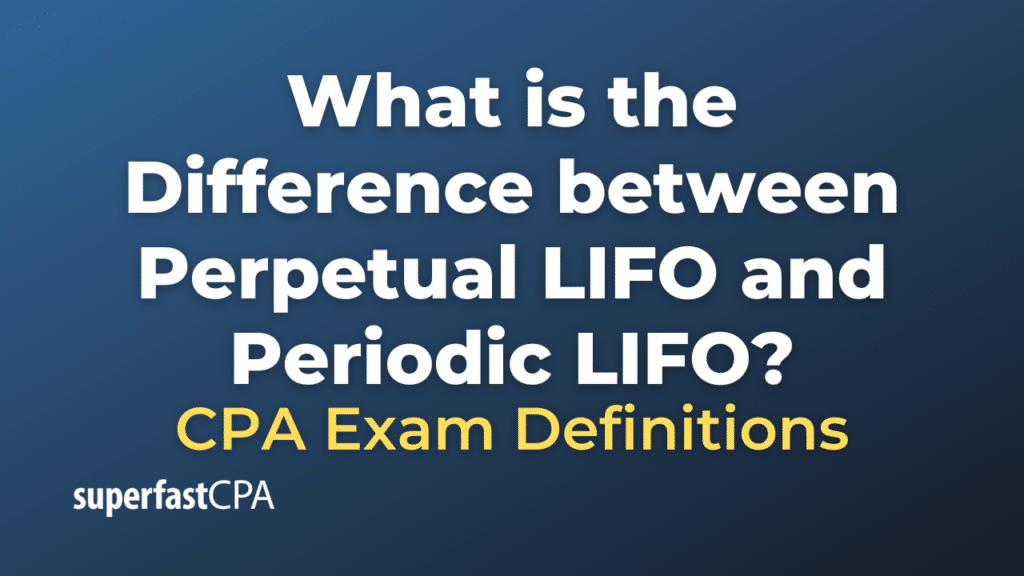Difference between Perpetual LIFO and Periodic LIFO
Perpetual LIFO and Periodic LIFO are two methods of inventory valuation that use the Last In, First Out (LIFO) principle, but they apply this principle in different ways.
- Perpetual LIFO: In the perpetual LIFO method, inventory and cost of goods sold (COGS) are updated continuously in real-time after each sale or purchase throughout the accounting period. This method keeps an ongoing record of the inventory on hand and the cost associated with it.For example, if a company sells a product, the cost of that sold product (which affects COGS) is based on the cost of the most recently purchased items in the inventory at the time of the sale.
- Periodic LIFO : In the periodic LIFO method, inventory and COGS are not updated with each individual transaction. Instead, these are updated at the end of the accounting period.For example, if a company sells a product, the cost of that sold product is not immediately determined. Instead, at the end of the accounting period, the company looks at all the units it purchased during that period and assumes that the items sold were those most recently purchased.
The key difference between the two lies in the timing of the inventory valuation and update. In Perpetual LIFO, inventory updates and valuations occur continually with each transaction, providing a more real-time view of inventory levels and costs. In contrast, Periodic LIFO calculates inventory and costs at the end of each accounting period, providing a view that may be more accurate in reflecting the cost flow at the end of the period but less accurate in tracking inventory and costs throughout the period.
It’s important to note that the choice between these two methods can have a significant impact on a company’s financial statements, particularly in times of fluctuating prices. Therefore, the decision should be made carefully, considering various factors such as the nature of the business, the volatility of prices, the complexity of inventory management, and regulatory requirements.
Example of the Difference between Perpetual LIFO and Periodic LIFO
Let’s consider a fictional company, ABC Widgets, which sells widgets. We’ll use a simplified example where ABC Widgets buys and sells only one widget during a given accounting period.
Scenario:
- January 1: ABC Widgets starts with 100 widgets in inventory, each costing $10.
- January 15: ABC Widgets purchases 50 more widgets, but the cost this time is $15 each due to increased manufacturing costs.
- January 20: ABC Widgets sells 75 widgets to a customer.
Let’s see how Perpetual LIFO and Periodic LIFO would handle this scenario:
Perpetual LIFO:
Under Perpetual LIFO, the inventory and cost of goods sold (COGS) are updated continuously. When ABC Widgets sells the 75 widgets on January 20:
- The last widgets that came in were the 50 widgets at $15 each, so these are the first ones sold. This means 50 widgets x $15 = $750 is added to COGS.
- Then, 25 out of the remaining 25 widgets sold will be those that cost $10 each. This means 25 widgets x $10 = $250 is also added to COGS.
- Therefore, the total COGS for the 75 widgets sold is $750 + $250 = $1,000.
The remaining inventory would be 75 widgets (125 widgets – 50 widgets sold), all at the original cost of $10, so the total inventory value would be 75 widgets x $10 = $750.
Periodic LIFO:
Under Periodic LIFO, the inventory and COGS are updated at the end of the accounting period, not continuously.
- At the end of the period (after the sale on January 20), ABC Widgets first calculates COGS. It assumes the last widgets purchased were the first ones sold, just like in perpetual LIFO. So the COGS calculation will come out the same as in perpetual LIFO, which is $1,000.
- The remaining inventory would also be the same, 75 widgets all at the original cost of $10 each, so the total inventory value would also be $750.
In this example, the results are the same for both methods. But keep in mind, results can differ when more purchases and sales are made throughout the period, especially when prices change. Perpetual LIFO could lead to different COGS and ending inventory values than Periodic LIFO, because it continuously updates with each transaction.














